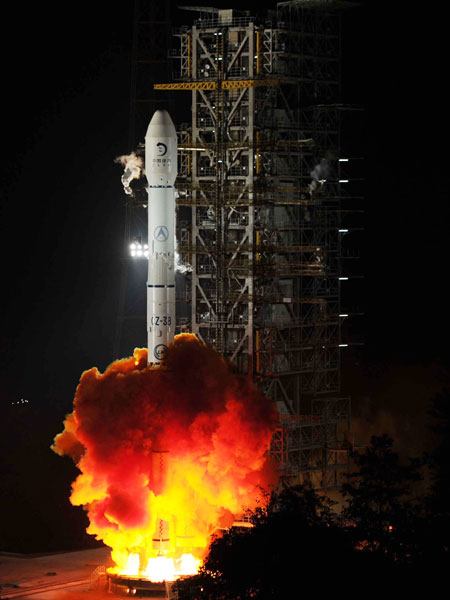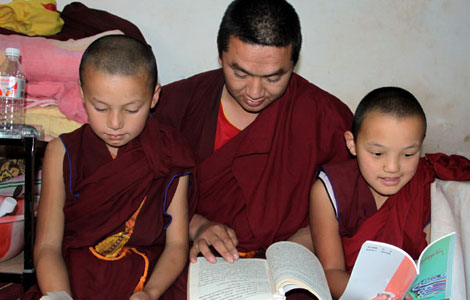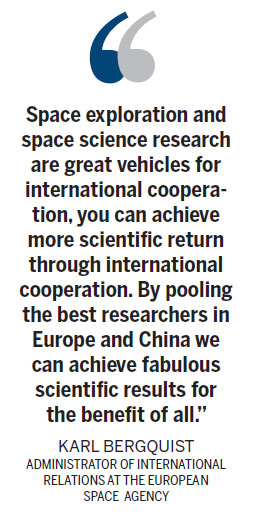Smooth start for Chang'e-3
Updated: 2013-12-03 09:06
By Zhao Lei in Xichang, Sichuan province, Fu Jing in Brussels, Chen Jia in San Francisco and Zhao Huanxin in Beijing (China Daily)
|
|||||||||||
Technical collaboration
During the spacecraft's flight, the European Space Agency will provide telemetry and tracking support for Chinese controllers. The collaboration will end once the Chinese spacecraft touches down in mid-December, if everything goes according to plan.
 |
|
Flames shoot from the base of the Long March-3B rocket on the launch pad as Chang'e-3 begins its journey to the moon. [Photo/Xinhua] |
"We are proud that the expertise of our ground station and flight dynamics teams can assist China to deliver a scientifically important lander and rover to the moon," said Thomas Reiter, ESA's director for human spaceflight and operations.
"Whether for human or robotic missions, international cooperation like this is necessary for the future exploration of planets, moons and asteroids, benefiting everyone," he said.
Karl Bergquist, administrator of international relations at ESA, said Chang'e-3 is another important step in lunar exploration because the rover will provide further analysis of the conditions on the satellite. So, from a scientific perspective, this is a very important mission, but technologically it is a much more complex undertaking than the two previous Chang'e missions.
"Space exploration and space science research are great vehicles for international cooperation, you can achieve more scientific return through international cooperation," he said. "By pooling the best researchers in Europe and China we can achieve fabulous scientific results for the benefit of all."
Mohsen Janatpour, planetarium director at the College of San Mateo in California, said he believes China's lunar project will add to the body of knowledge in several ways, through collaboration, corroboration, cooperation, competition and communication with NASA's Lunar Atmosphere and Dust Environment Explorer, which is known in scientific circles as LADEE.
Yutu is equipped with alpha particle X-ray and infrared spectrometers, which will enable in-depth analysis of soil samples, he said.
Furthermore, the lander, which is equipped with an astronomical telescope fitted with an extreme ultraviolet camera, will serve as the first moon-based observatory, he added.
The information obtained will augment that gathered by LADEE, which orbits the moon at an altitude of approximately 250 kilometers.
"The Chang'e lunar observatory will contribute to, and expand, our knowledge of outer space and corroborate our other findings," said Janatpour.
He admitted that there has been speculation that the disturbance of the lunar dust and Chang'e-3's exhaust could contaminate the lunar atmosphere and interfere with the LADEE mission.
"However, I believe that with the proper communication and collaboration, any disturbances can be utilized and taken advantage of by LADEE as an atmospheric experiment. From what I have read, there would be very little or no impact on the baseline information gathered by LADEE," he said.
Charles Alcock, director of the Harvard-Smithsonian Center for Astrophysics in Massachusetts, said he was very excited to see China advance further in terms of space science, astrophysics and cosmology.
"I wish the team working on Chang'e-3 the best of luck, and hope they are successful."
Julia C. Lee, associate professor of astronomy at the center, said she found it uplifting that China has focused so much of its financial resources on science and technology and in that way is investing in the future.
Xinhua News Agency contributed to the story
Related Stories
Chang'e-3 trims its orbit 2013-12-02 20:16
Lunar probe boosts 'Chinese dream' 2013-12-02 18:53
China's lunar probe enters earth-moon transfer orbit 2013-12-02 04:26
China announces launch of Chang'e-3 lunar probe "successful" 2013-12-02 03:16
China launches moon rover 2013-12-02 02:53
Today's Top News
China-UK collaboration is about time: President Xi
Biden's Asian visit under pressure
FTZ OKs offshore accounts
Survey shows Chinese holiday preference
Pandas to arrive Brussels in spring
China's rise 'an opportunity' for UK
China launches moon rover
Honor Cairo Declaration
Hot Topics
Lunar probe , China growth forecasts, Emission rules get tougher, China seen through 'colored lens', International board,
Editor's Picks

|

|

|

|

|

|





